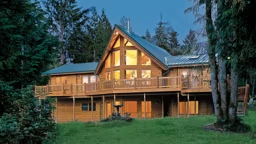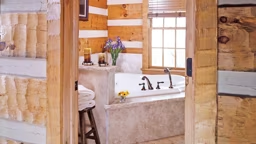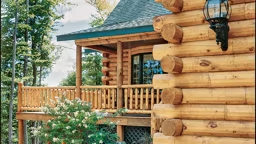
Within the last 2 decades, the quest for character-filled antique timber has evolved into a full-fledged industry. Old barns, warehouses, army barracks, and even river bottoms are providing companies with reclaimed--or old-growth--wood.
Everything from recycled oak wine barrels to 300-year-old curly heart pine is being transformed into one-of-a-kind floors and furniture. No doubt, reclaimed flooring and interior accents make a long-lasting impression. “Wood is a one of kind natural element, which regardless of age, possesses unique characteristics in each board,” says Anita Howard, communications director of the National Wood Flooring Association.
One company specializing in recycled wood flooring, Terra Mai (McCloud, California), lists some of the attributes of reclaimed wood over new:
- Reclaimed wood is filled with rich grain patterns, character marks, deep colors, and distinct patinas. It’s impossible to replicate antique wood because there is nothing new like it.
- It’s had years to air-dry and is much less likely to bend, warp or twist over time. Many companies kiln dry the wood upon its recovery to assure very low moisture content.
- Because most reclaimed wood comes from old growth trees it contains fewer knots and other natural defects often found in newer wood.
- Old-growth wood is characterized by its higher ring count per inch than new wood. More rings equals stronger more durable wood, ideal for applications where there is high traffic or greater wear.
When is wood classified as “antique” and “reclaimed?”
Wood that is a minimum 100 years old is considered “antique.” Once this antique wood is salvaged and applied to a new use, it is referred to as “reclaimed.”How is wood defined as “old growth?” Is all reclaimed wood considered “old growth?”
“The most straightforward definition comes from the USDA Forest Service, which said the approximate age at which old-growth features begin to appear is about half the maximum age of the predominant tree species,” says Kathy Fleming of Hardwood Magazine. Because most of the structures being deconstructed today are more than 100 years old, it is fair to say that in most cases reclaimed wood originates from old-growth timber. According to the Reclaimed Wood Council (www.reclaimedwoodcouncil.org), old-growth forests are at least 200 years old. An estimated 8 to 9 million acres of old-growth forests remain today primarily on protected federal land. Nearly 90 percent of our old-growth forests have already been logged.
This reclaimed oak flooring from KD Woods Company is salvaged from an antique fence at a horse ranch. Photo: courtesy KD Woods Company.
What types of wood are typically reclaimed?
Heart pine, chestnut, and oak seem to be the most readily available. Other species of pine, elm, cypress, and ash can also be found. Some companies derive their product from reclaimed exotic hardwoods found overseas, but the primary sources are recovered in the United States. Wood types can vary within different regions of the country.Where does this old wood come from?
Most antique timber is taken from old and dilapidated buildings, including barns, warehouses and military barracks. Other sources are river floors, where wood has been underwater for hundreds of years. Nature has another way of speeding up the deconstruction process — hurricanes and storms leave a trail of debris from old structures.Because no board is the same, is it possible to have an antique floor made from similar-looking wood?
Yes, as long as “similar” does not mean “identical.” Every company has its own re-milling process and standards. Because many of the wood sources are very large, the salvaged wood is generally kept together for future applications.
Reclaimed heart pine wood flooring. Photo: courtesy Longleaf Lumber.
Why is salvaged heart pine from riverbeds so strong?
Wood that has been underwater for over a hundred years has lost everything except the heartwood at its center. Instead of dissipating, this portion of the log has been preserved in its oxygen-free underwater sanctuary. “The dense logs settled in the river depths, where the cool water temperature and lack of oxygen acted as natural preservation, precluding deterioration of the wood,” says Carol Goodwin, co-owner of Goodwin Heart Pine Company in Micanopy, Florida. As an example of the durability of this submerged lumber, Goodwin’s wood is 200 to 500 years old.What is engineered reclaimed wood flooring?
Historic Woods Inc., Shelburne, Ontario, has developed engineered flooring made by attaching antique wood to a plywood base. The method of affixing the wood can vary: It can be glued, stapled, and nailed; it can be put over concrete or wood. Engineered antique hardwood flooring is often used in lieu of solid wood where variable humidity levels require more stability. It also works very well over radiant heat systems.Can I use reclaimed wood over radiant heat?
“Reclaimed flooring works well with radiant heat due to its density and very low moisture content,” says Matt Nichols, marketing manager for Terra Mai. The most important factor, according to Mountain Lumber Company, in Ruckersville, Virginia, is proper acclimation of the wood flooring and the surrounding materials. The slab, plywood subfloor, and/or joists should be acclimated to within 3-4% of each other.











